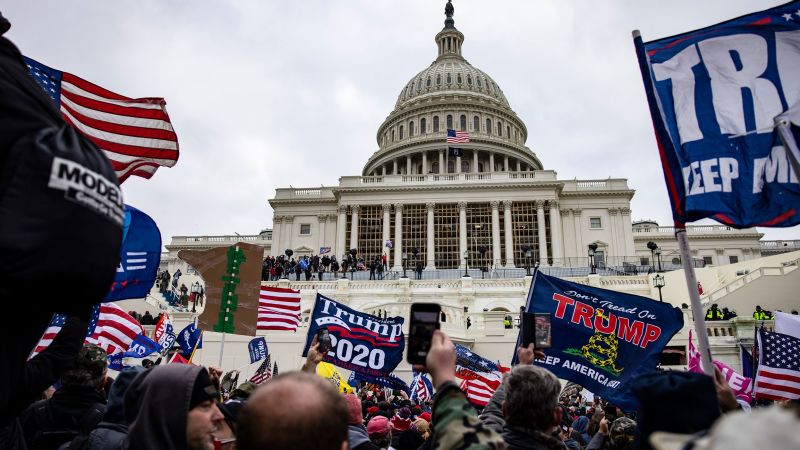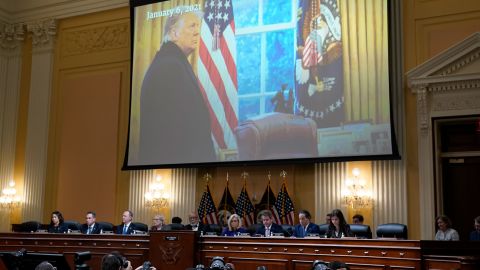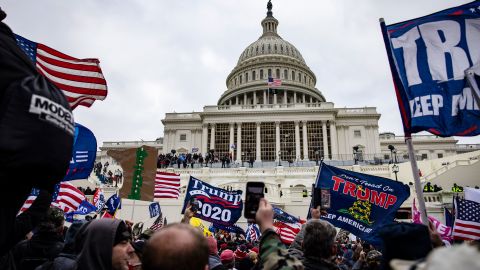
CNN
—
The House select committee investigating the January 6, 2021, insurrection recommends barring former President Donald Trump from holding office again.
The recommendation is among the conclusions of the panel’s final report, a comprehensive overview of the bipartisan panel’s findings on how Trump and his allies sought to overturn the 2020 presidential election, released late Thursday evening.
The 845-page report – based on 1,000-plus interviews, documents collected including emails, texts, phone records and a year and a half of investigation – includes allegations that Trump “oversaw” the legally dubious effort to put forward fake slates of electors in seven states he lost, arguing that the evidence shows he actively worked to “transmit false Electoral College ballots to Congress and the National Archives” despite concerns among his lawyers that doing so could be unlawful.
In a symbolic move Monday, the committee in its last public meeting referred Trump to the Justice Department on at least four criminal charges, while saying in its executive summary it had evidence of possible charges of conspiring to injure or impede an officer and seditious conspiracy.
“That evidence has led to an overriding and straight forward conclusion: the central cause of January 6th was one man, former President Donald Trump, whom many others followed. None of the events of January 6th would have happened without him,” the report states.
Committee Chairman Bennie Thompson, a Mississippi Democrat, said on Monday that he has “every confidence that the work of this committee will help provide a road map to justice, and that the agencies and institutions responsible for ensuring justice under the law will use the information we’ve provided to aid in their work.”
Special counsel Jack Smith is leading the Justice Department’s investigations related to Trump, including both his post-election actions and classified documents found at his Mar-a-Lago resort earlier this year.
Trump swiftly lashed out over the report on his Truth Social platform with false claims about the riot and the 2020 election. He did not address specific findings from what he called the “highly partisan” report but instead falsely blamed House Speaker Nancy Pelosi for the breakdown in security that day and resurfaced his unfounded claims of election fraud.
Here’s what’s in the report:
In an effort to overturn election results in key states, Trump and his inner circle targeted election officials in “at least 200 apparent acts of public or private outreach, pressure, or condemnation,” between Election Day and the January 6 attack, according to the report.
There were 68 meetings, attempted or connected phone calls, or text messages, aimed at state or local officials, as well as 125 social media posts by Trump or senior aides targeting state officials.
Trump “spearheaded outreach aimed at numerous officials in States he lost but that had GOP-led legislatures, including in Michigan, Pennsylvania, Georgia, and Arizona,” the report says. (He lost all of those states.)
For example, during a January 2, 2021, call between Trump and Georgia Secretary of State Brad Raffensperger, the then-president went through a “litany of false election-fraud claims” and then asked Raffensperger to deliver him a second term by “finding” just enough votes to ensure victory, according to the report.
Trump infamously said, “I just want to find 11,780 votes, which is one more than we have because we won the state.”
The January 6 committee identifies a little known pro-Trump attorney as being the original architect of the legally dubious fake electors plan: Kenneth Chesebro.
Conservative attorney John Eastman authored a now-infamous memo detailing step-for-step how then-Vice President Mike Pence could theoretically overturn the 2020 election results. But the committee points to Chesebro, a known associate of Eastman, as being responsible for creating the fake electors plot.
“The fake elector plan emerged from a series of legal memoranda written by an outside legal advisor to the Trump Campaign: Kenneth Chesebro,” the report says.
It was previously known that Chesebro was involved in the fake electors scheme, but the committee’s conclusion about his leadership role is new.
The effort to put forward fake slates of pro-Trump electors is under scrutiny by federal and state prosecutors investigating efforts by Trump and his allies to overturn Joe Biden’s election victory in 2020.
The committee wrote that Chesebro sent a memo to then-Trump lawyer Rudy Giuliani after a request from Trump campaign official Boris Epshteyn about a “‘President of the Senate’ strategy,” which wrongly asserted that the vice president could pick which presidential electors to count during the joint session of Congress on January 6.
“President Trump in the days immediately before January 6th, Chesebro – an attorney based in Boston and New York recruited to assist the Trump Campaign as a volunteer legal advisor – was central to the creation of the plan,” the report says. “Memos by Chesebro on November 18th, December 9th, and December 13th, as discussed below, laid the plan’s foundation.”
CNN has previously asked Chesebro to comment about these topics and he has not responded.
Eastman reached out to speak to Trump on December 23, 2020, the same day that he drafted his initial memo on the Pence theory.
Eastman emailed Trump’s assistant, Molly Michael, at 1:32 p.m., according to the committee. “Is the President available for a very quick call today at some point? Just want to update him on our overall strategic thinking.”
The committee wrote that Eastman received a call from the White House switchboard, and the call lasted 23 minutes, according to Eastman’s phone records. Eastman’s two-page memo discussed various ways to ensure “President Trump is re-elected,” even though by then, he had been projected to lose the election, according to the committee.
These new details show how the committee used emails and phone records it obtained after it successfully fought in court to obtain the documents.
The committee obtained Eastman’s emails after a judge sided with the House in a lawsuit where the committee accused both Eastman and Trump of a criminal conspiracy to obstruct Congress and to defraud the government.
Trump latched onto Eastman’s theories that incorrectly claimed Pence could overturn the election, and launched a pressure campaign against Pence in the days leading up to January 6. Eastman was present at a January 4, 2021, meeting between Trump and Pence in the Oval Office where Trump tried to convince Pence he could intervene when Congress certified the Electoral College vote on January 6.
Barring Trump from further public office is one of 11 recommendations the committee is making as a result of its investigation.
The panel zeroes in on the section of the Constitution that states an individual who has taken an oath to support the US Constitution but has “engaged in an insurrection” or given “aid or comfort to the enemies of the Constitution” can be disqualified from office. The former president and others have been referred by the committee to the Department of Justice for assisting or aiding an insurrection.
It calls on congressional committees of jurisdiction to create a “formal mechanism” for evaluating whether those individuals violate that section of the 14th Amendment should be barred from future federal or state office.
In addition to criminal referrals, the select committee is calling for lawyers involved in the efforts to overturn the election to be held accountable.
“Those courts and bar disciplinary bodies responsible for overseeing the legal profession in the states and the District of Columbia should continue to evaluate the conduct of attorneys described in this Report” the panel writes, adding that there are specific attorneys the report identifies as having “conflicts of interests” for the Department of Justice to evaluate.
The report even calls on Congress to amend statutes and consider the severity of penalties that deter individuals from efforts to obstruct, influence or impede the Joint Session of Congress that certifies election results. It calls for statutes of federal penalties for certain types of threats against election workers to be strengthened.
Although the panel was successful in getting more than 1,000 witnesses to testify as part of its investigation, it still had difficulty gaining cooperation from everyone it wanted to speak to. Its report recommends congressional committees of jurisdiction “develop legislation” to create “a cause of action” for the House to enforce its subpoenas in federal court.
One recommendation may soon become reality.
The panel calls on Congress to pass an overhaul of the 1887 Electoral Count Act aimed at making it harder to overturn a certified presidential election – the first legislative response to the insurrection and Trump’s relentless pressure campaign to stay in power.
The House and Senate have each passed their own version of the legislation.

The House committee lays out a number of criminal statutes it believes were violated in the plots to stave off Trump’s defeat and says there’s evidence for criminal referrals to the Justice Department for Trump, Eastman and “others.”
The report summary first released Monday says there’s evidence to pursue Trump on multiple crimes, including obstruction of an official proceeding, conspiracy to defraud the United States, conspiracy to make false statements, assisting or aiding an insurrection, conspiring to injure or impede an officer and seditious conspiracy.
The panel says it also has the evidence to refer Eastman on the obstruction charge, and it names him as a co-conspirator in other alleged criminal activity lawmakers have gathered evidence on.
The committee alluded to evidence of criminal obstruction of the House investigation but the summary does not go into detail about that evidence.
The committee outlines 17 findings from its investigation that underpin its reasoning for criminal referrals, including that Trump knew the fraud allegations he was pushing were false and continued to amplify them anyway.
“President Trump’s decision to declare victory falsely on election night and, unlawfully, to call for the vote counting to stop, was not a spontaneous decision. It was premeditated,” the report states.
The committee also revealed emails from Tom Fitton, president of the conservative group Judicial Watch, from before the 2020 presidential election that say Trump should declare victory regardless of the outcome.
It notes that Trump’s top allies, including those who testified before the committee, acknowledged they found no proof to back up the former president’s claims.
“Ultimately, even Rudolph Giuliani and his legal team acknowledged that they had no definitive evidence of election fraud sufficient to change the election outcome,” it adds, referring to Trump’s then-personal attorney.
“For example, although Giuliani repeatedly had claimed in public that Dominion voting machines stole the election, he admitted during his Select Committee deposition that ‘I do not think the machines stole the election,’” it states.
The committee investigators describe how Trump campaign and Republican National Committee fundraising pitches containing false claims of a stolen election ultimately raised more than $250 million – but were met internally with some resistance.
Investigators describe three options that were considered for a post-election fundraising appeal by the campaign. One option, that the campaign opted against using because they knew it was false, said that Trump had won. A second unused option said the campaign was waiting on results. Ultimately, according to the committee, the Trump campaign approved a message that Democrats are going to “try to steal the election” that was written before election night.
The committee describes, based on interview with Trump campaign officials, that much of the material in the fundraising emails was based on messages said by Trump – but were not checked for accuracy before being used to ask for donations.
“President Trump’s claims were treated as true and blasted to millions of people with little to no scrutiny by those tasked with ensuring accuracy,” the committee wrote.
Trump campaign’s deputy director of communications and research Zach Parkinson told investigators that reviews for accuracy were limited to “questions concerning items such as time and location.”
The RNC did eventually tone down some messages, which the committee suggests shows “the RNC knew that President’s Trump’s claims about winning the election were baseless” and made “changes to fundraising copy that seemingly protected the RNC from legal exposure,” according to investigators.
House investigators said that RNC lawyers directed copywriters not to use the term “rigged,” according to interviews conducted by the committee. The panel obtained several examples of fundraising appeals that were toned down to be accurate and less inflammatory.
White House communications director Hope Hicks told the January 6 committee that Donald Trump had laughed at one of his election lawyer’s claims about foreign powers interfering in the election, calling them “crazy,” according to the committee’s final report.
“The day after the press conference, President Trump spoke by phone with Sidney Powell from the Oval Office. During the call, Powell repeated the same claims of foreign interference in the election she had made at the press conference,” the report said, referring to conspiratorial claims made by Powell, Trump’s onetime attorney, at an outlandish press conference after the 2020 election.
“While she was speaking, the President muted his speakerphone and laughed at Powell, telling the others in the room, ‘This does sound crazy, doesn’t it?’” the report says.
During the press conference, Powell falsely claimed, among other things, that widely used voting machines from the election technology company Dominion Voting Systems featured software created “at the direction” of deceased Venezuelan President Hugo Chavez to swing his own election results, and that the company has ties to the Clinton Foundation and George Soros.
“A few days later, the Trump campaign issued a statement claiming Powell was not part of the Trump campaign’s legal team. But Powell’s outlandish claims were no different from those President Trump was making himself,” the committee writes.

The committee lays out Trump’s failure to act as the riot unfolded, noting that as he watched the riot on television, he made no calls for security assistance and resisted efforts from staffers asking him to call off his supporters.
“President Trump did not contact a single top national security official during the day. Not at the Pentagon, nor at the Department of Homeland Security, the Department of Justice, the F.B.I., the Capitol Police Department, or the D.C. Mayor’s office,” the committee writes. “As Vice President Pence has confirmed, President Trump didn’t even try to reach his own Vice President to make sure that Pence was safe.”
Milley, chairman of the Joint Chiefs of Staff, told the committee he had this reaction to Trump, “You know, you’re the Commander in Chief. You’ve got an assault going on on the Capitol of the United States of America. And there’s nothing? No call? Nothing? Zero?”
White House staffers, meantime, described being appalled that as the Capitol was under attack, Trump fired off a tweet criticizing Pence.
Hicks texted a colleague that night to say, “Attacking the VP? Wtf is wrong with him,” according to the committee’s summary report.
“No photographs exist of the President for the remainder of the afternoon until after 4 p.m. President Trump appears to have instructed that the White House photographer was not to take any photographs,” the committee writes, citing testimony from former White House photographer Shealah Craighead.
In the aftermath, on the evening of January 6, Trump’s former campaign manager Brad Parscale told Katrina Pierson, one of the rally organizers, that he felt guilty helping Trump win, the report states.
The events of the day, Parscale said, resulted from “a sitting president asking for civil war.”
Trump’s tone during his last known phone call on January 6 was like, “wow, can you believe this sh*t?” according to the White House aide who spoke with him that night.
In newly revealed testimony included in the January 6 committee’s final report, the aide, John McEntee, said Trump told him “[t]his is a crazy day.” The report added, “McEntee said his tone was one of “like, wow, can you believe this sh*t?”
Trump did not express any sadness over the violence that had unfolded at the Capitol that day, McEntee told the panel.
“I think he was shocked by, you know, it getting a little out of control, but I don’t remember sadness, specifically” McEntee said.
He wasn’t the only person with that impression about Trump’s mood.
Ivanka Trump, a senior White House adviser at the time, told the select committee her father was “disappointed and surprised” by the attack on the Capitol.
But when pressed by committee investigators, she could not provide any instances of the president discussing whether or not he did the right thing on January 6 or speaking about those who were injured or died that day.
This story has been updated with additional details.
